Key points
- This study looked at how to increase plant biodiversity in agricultural landscapes.
- Over nine years, all the streams, ponds and ditches in three upper catchments in Leicestershire were surveyed.
- Creating clean water ponds was beneficial, increasing the number of plant species, especially the number of rare plant species.
- When nothing was done, biodiversity decreased.
- Creating clean water ponds to target biodiversity has the significant potential to hold, and even reverse, the decline in the diversity of plants found in freshwaters across farming landscapes.
Background
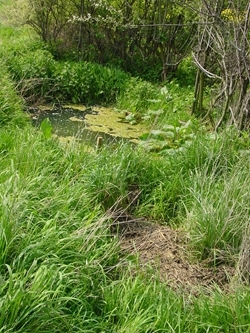 Agriculture plays an important part in influencing aquatic ecosystems, such as ponds and ditches, in farming landscapes. For these ecosystems to be successful, there needs to be a good number and variety of different species living within them. Different methods can be used to improve their biodiversity, including debris dams, flow deflectors, restoring rivers and creating and managing ponds.
Agriculture plays an important part in influencing aquatic ecosystems, such as ponds and ditches, in farming landscapes. For these ecosystems to be successful, there needs to be a good number and variety of different species living within them. Different methods can be used to improve their biodiversity, including debris dams, flow deflectors, restoring rivers and creating and managing ponds.
There are also several techniques used to help ease the impact agriculture has on these freshwater environments. This includes methods to control pollutants moving from fields into nearby water, such as fences alongside riverbanks, buffer strips and constructing wetlands. Holding back water in rivers or ponds can also help lessen the impact from agriculture. Previously, these methods have shown varying results, with little evidence they significantly improve biodiversity. There is limited understanding of the benefits they can bring, especially for ponds, headwaters, and ditches, which typically support a high proportion of biodiversity.
This research aimed to assess how introducing a variety of measures to ponds, streams and ditches could improve landscape-scale biodiversity of the aquatic plants. This was part of the Water Friendly Farming project, a long-term experiment to investigate the effectiveness of measures used across the landscape to reduce the impact of rural land use on water while still maintaining profitable farming. The project is a collaboration between the Freshwater Habitats Trust, the University of York, and other partners. The Freshwater Habitats Trust led on the biodiversity surveys that form the focus for this summary.
What they did
For this study, three areas of the River Welland and the River Soar in Leicestershire, England were used. These were Barkby, Eye and Stonton (Figure 1).
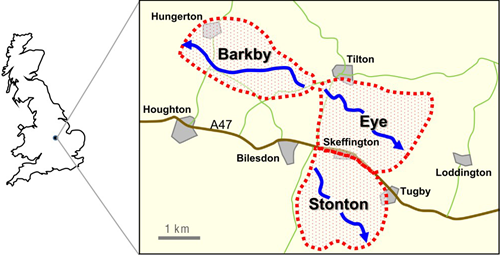
Figure 1: Location of the three headwater catchment areas used.
A series of ecosystem service measures were used to slow the flow of water, intercept polluted water and sediment and store flood water. This included inserting dams in streams and ditches to hold back water and trap sediment (Figure 2). Ponds were used to collect field runoff and store water during flood periods, known as interception ponds. These measures were added to Eye Brook and Stonton catchments.
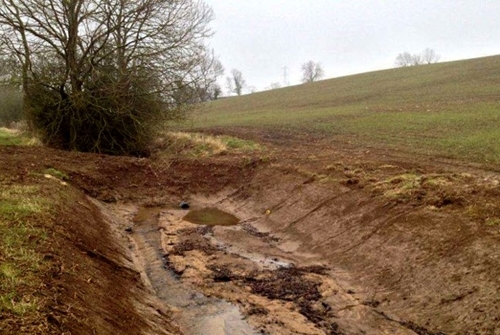
Figure 2: Bunded ditches, an earth bank inserted into a ditch with a
small pipe to slow the flow of water and encourage the sediment to settle.
Two biodiversity measures were introduced to Stonton only: these were clean water ponds and woody debris dams. Clean water ponds are areas of water not connected to a stream or ditch, where they can fill with unpolluted surface water or ground water (Figures 3-5). 20 new clean water ponds were created in the 900ha catchment. Woody debris dams are used in stream and river restoration to increase habitat diversity (Figure 6).
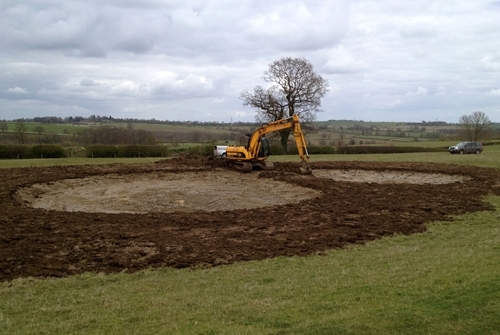
Figure 3: Creating a clean water pond.
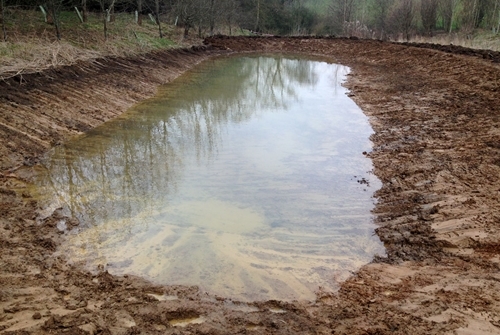
Figure 4: Clean water pond begins to develop.
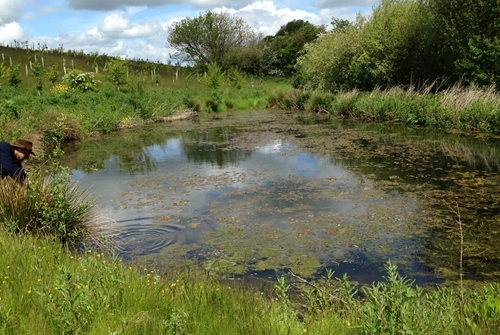
Figure 5: A new clean water pond.
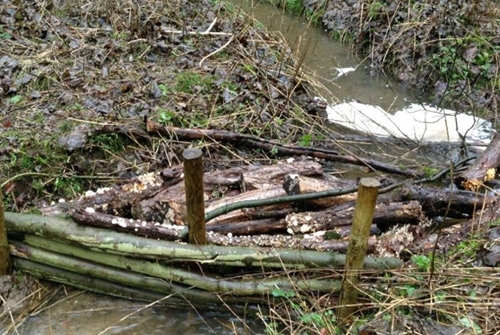
Figure 6: Debris dams made from wood and creating habitats.
To examine how effective these measures were, the scientists surveyed all the plants yearly throughout the project, examining which species were gained and lost. This monitoring was done for three years before the measures were put in place in 2013/2014, and continued annual monitoring took place between 2014 to 2018. No new habitats were put in place in Barkby; it was used as a reference site to examine what would happen without any intervention.
What they found
When there were no measures in place, 106 different wetland plant species were recorded across the 3,000ha landscape during the survey. Looking at the difference across the three waterbody types, ponds had the highest number of species (an average of 85.5 per year) while streams and ditches only had around half of this. Without any measures in place, the number of plant species decreased by 10% over the nine years. The reference catchment initially had the most species but suffered the greatest decline, losing 14% during the survey period, with ponds losing the most.
Five years after the scientists installed the different measures, clean water ponds were the most successful intervention. These ponds had the highest plant biodiversity. Other measures such as debris dams, blocking streams and ditches with a bank and ponds that catch run-off before releasing it to a stream or ditch (interception ponds) were not as effective as clean-water ponds, and did not increase biodiversity compared to the reference.
Only clean water ponds and interception ponds supported rare species, with the clean water ponds supporting rare species that were new or had recently become locally extinct. Adding the clean water ponds increased the total plant richness by 26% and the number of rare plant species by 181%. In Stonton, the clean water ponds restored 31% of lost species but debris dams did not have any returning species of plants.
What does this mean?
Without any measures, there was a decline in the number of plant species across ponds, streams, and ditches during the nine years of the survey. The results show a continued loss of plant diversity in this lowland agricultural landscape, reflecting findings from other areas.
Adding the measures we studied brought immediate biodiversity gains. Five years after creating clean water ponds, they added as much biodiversity as was seen to be lost when no measures were added. The number of rare species were tripled and the richness of plant species as a whole increased by a quarter. In some cases, these new ponds can be richer than the pre-existing ponds. In new ponds, there is limited competition during the first few years, providing opportunities to plants to thrive. Furthermore, when a pond is created, the soil disturbance may expose seeds that were dormant and allow plants no longer seen in the area to grow and develop. There was also evidence to suggest that new ponds helped improve biodiversity of pre-existing ponds. The Stonton catchment received the most nature-based measures and saw the lowest rate of species loss.
Whether these gains in biodiversity remain in the long-term is an open question. Evidence does suggest that clean water ponds can retain this high level of biodiversity for many decades. Longer-term monitoring is needed to understand whether they can maintain this in an agricultural landscape. The potential future biodiversity from interception ponds is more doubtful. This is because they will degrade once they fill with polluted sediment and water, which is their role as an interception pond. They are likely to suffer a short to medium decline in biodiversity.
Wetland plants remain vulnerable to future losses, with some species becoming extinct in certain bodies of water. During this study, multiple species became extinct from water bodies because of a change in or destruction of their habitat, including channelling streams, planting fens and fencing livestock away from the edge of water. There is a further threat from habitats becoming more isolated, where populations become smaller and may become extinct within that area. The majority of plant species, including rare species, were found in ponds.
Ponds are a key habitat in the agricultural landscape, supporting the highest number of freshwater plant species, the most uncommon species and the most rare species. There is a growing call for ponds to be monitored as part of water quality assessment. Furthermore, there is a lack of water and nature conservation policies that support pond protection despite evidence that small habitats like ponds are important for biodiversity. This study adds further weight to the discussion that ponds should be included in policy and legislation to reduce the loss of freshwater biodiversity. Habitat creation measures such as clean water ponds can make a positive difference to agricultural landscapes and the freshwater plant biodiversity within them.
Read the original abstract
Williams, P., Biggs, J., Stoate, C., Szczur, J., Brown, C., Bonney, S (2020). Nature based measures increase freshwater biodiversity in agricultural catchments. Biological Conservation 244, 108515, ISSN 0006-3207.